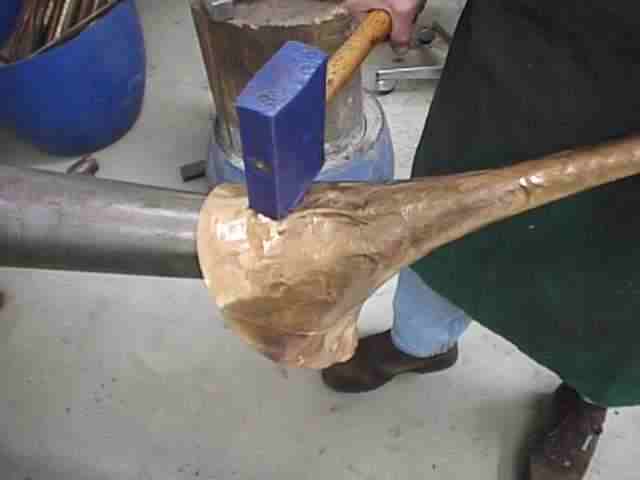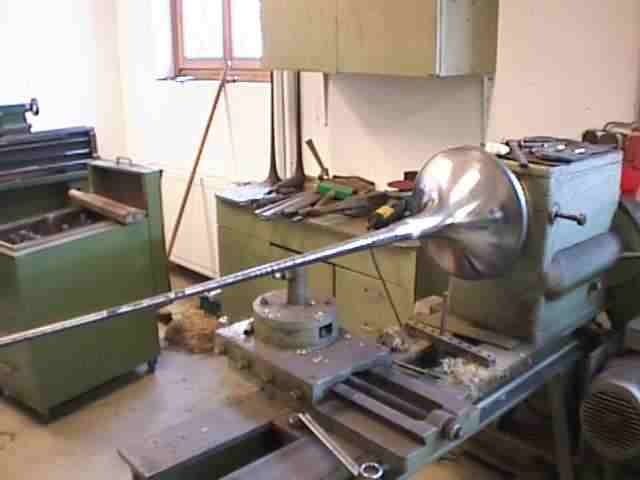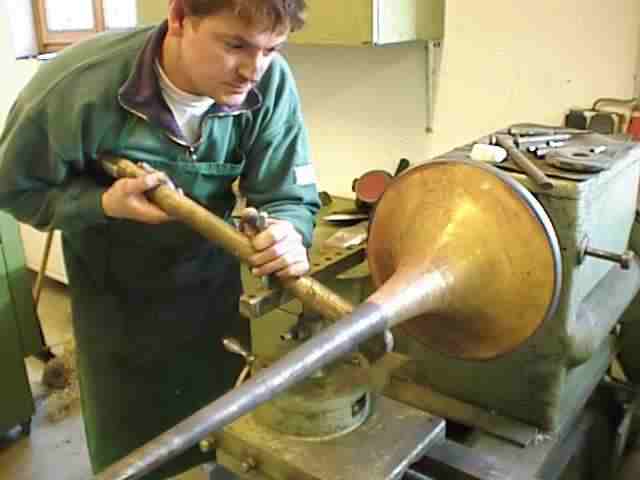|
|
|
|
The making of the Pizka-ClassicDouble Horn
the rough body with the valve housing
The
valve cylinders are made out of solid
The finger plates are superbly decorated with mother-of-pearl-inlay, also the back screw & the valve caps. The horn sounds like ..... Get my CDs, and you will know it. Even if you use the F-side, you will not have any problem reaching the "higher altitude" safely. Even Beethoven No.2 is getting out of the "dangerous solo list" with this instrument. The bell making:
a)
the bell is cut from sheet metal, folded and
b)
detail of the seam with the "teeth"
c)
the bell is roughly formed with the
plastic
d) and heated up to 590 - 600 centigrades again to soften the metal this process is repeated several times e) a hardwood tool is used to widen the bell (right) f) Robert Worischek forms the outside of the bell, again using the hardwood tool g) the thinner part of the bell section is rounded using a self made tool (right)
h)
a metal tool is used for the fine i) the last polish is done to remove any oxide layer (right)
j) the long bell mandrel made of steel, specially made by the tool maker Boehm on special order (above) k) the bell is taken off the steel mandrel (right)
l)
the bell is cut finally and the bell screw
(m)
is
attached. A nickel silver garland (kranz) The "kranz" function as some kind of "fortissimo break", so to prevent the often heard noise, if the horn is "overplayed".
m)
Even with a screw bell, the bell section is There is no problem, to have the horn with the bell uncut. But there is no light weight case. The price is higher for € 500.-. This is the price for the "naked" horn. One has to understand the price difference, as the work with an uncut bell takes more time.
click here for the HPE Index
click here for the Pizka-Classic page: PizClasHr.htm click here for the Viennese mouthpieces: mpiece.htm |
Die Herstellung des Pizka-Classic Doppelhorns
der rohe Korpus mit dem Ventilgehäuse. Die zylindrische Bohrung beträgt 10.8 mm (innerer Durchmesser der zylindrischen Rohre) also die gleiche Bohrung wie beim berühmten Wiener F Horn
Die Ventilzylinder werden aus korrosionsfestem Messing gefertigt. Sie sind mit etwa 1 Grad konisch. Die Gehäuse sind aus Neusilber. Dieser geringe Konus garantiert die Dichtheit der Ventile.Die Drückerplatten sind aus echtem Perlmutt, Rückschrauben und Ventildeckel sind ebenso mit Perlmutt verziert. Das Horn klingt ... Hören Sie doch in eine meiner CDs hinein. Selbst auf der F-Seite gibt es keine Probleme, die "Höhe" sicher zu erreichen. Selbst Beethovens Zweite kann beim Gebrauch dieses Horns von der Liste der "gefährlichen Stellen" gestrichen werden.
So wird der Becher gemacht: a) Der Becher wird aus Messingblech zugeschnitten, gefalzt und an der Naht verlötet. b) Detail der Naht mit den kleinen Zähnchen. Gelötet wird mit einem Speziallot. c) Der Becher wird mit einem Kunststoffhammer roh auf dem Amboß geformt. d) Anschließend wird er auf 590-600 Grad erhitzt um das Metall weicher und besser formbar zu machen. Dieser Prozeß wird mehrmals wiederholt.
e) ein Hartholzwerkzeug findet bei der Aufweitung des Schallbechers Verwendung (unten)
f) Robert Worischek formt die Außenseite des Bechers unter der Verwendung eines weiteren Hartholzwerkzeuges.(oben)
g) Der dünnere Teil des Schallstückes wird mit einem selbst gebauten Werkzeug gerundet (oben). h) Die Oberfläche wird mit einem Metallwerkzeug geglättet (links)
i) Ein letztes Polieren und gleichzeitiges Entfernen der Oxydschicht.(oben) j) Der lange stählerne Schallstückdorn; eine Spezialanfertigung der Firma Böhm. (links)
k) Das fertige Schallstück wird vom Dorn genommen (oben)
l) Am Schluß wird der Becher abgetrennt und mit dem Spezialgewinde versehen. Ein Neusilberkranz schmückt und verstärkt den Becher. Der Kranz funktioniert auch als "Fortissimobremse" und verhindert das "Überblasen" (Klirren). m) Selbst bei abschraubbarem Becher wird das Schallstück zuerst aus einem Stück hergestellt und spatter abgeschnitten. Damit werden unnötige Spannungen im Metall verhindert, Spannungen, die man meist in jenen Bechern findet, die aus Flachmaterial auf der Scheibe gedrückt werden. Das Schraubgewinde ist ein Trapezoidgewinde mit grobem und stumpfem Schraubgang. m) links: Robert Worischek mit einem rohen ungeformten Schallstück und einem noch geraden bereits vorpolierten Schallstück.
Es kann auch ein Horn mit festem Becher gebaut werden, jedoch ist dann der Preis € 5.200.- statt € 4.700.-. Der Preisunterschied ist daher zu verstehen, daß die Arbeit mit festem Schallbecher viel aufwendiger ist. click below for the main index:
click here for the
|




 c
c












